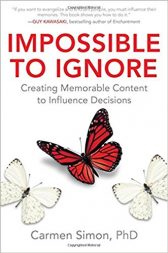Carmen Simon, PhD is changing how the world communicates. A cognitive neuroscientist, she has helped some of the world’s most visible brands craft memorable messages by focusing on how the brain works.
Carmen is the founder of Memzy, an agency that helps corporations use brain science to create memorable messages that influence customers’ decisions. Carmen has two doctorate degrees, one in instructional technology and another in cognitive psychology, and is a recognized expert in applying neuroscience to leadership, communication design, and customer engagement. Her most recent book, Impossible to Ignore: Creating Memorable Content to Influence Decisions, has been selected as one of the top books on persuasion. Her sought-after keynote speeches unveil science-based techniques for getting others to see your way, remember your way, and go your way.
More About Carmen Simon…
Audiences forget up to 90% of what you communicate. How can your employees and customers decide to act on your message if they only remember a tenth of it? How do you know which tenth they’ll remember? How will you stay on their minds long enough to spark the action you need? Many experts have offered techniques on how to improve your own memory, but not how to influence other people’s memory?and impact their decisions. Drawing on the latest research in neuroscience and cognitive psychology, Carmen Simon reveals how to avoid the hazards of random recall and create content that influences what people do next.
Questions? Contact Us Any Time:
805.965.1400
info@bigspeak.com
She is a frequent speaker at industry events and her presentations are filled with case studies, examples, and immediately practical techniques to help you put the power of cognitive science to work for your business. Whether you’re leading an organization, communicating with others, delivering training, making a sales pitch, or creating a marketing campaign, these field-tested techniques will help you develop messages that speak to people’s hearts, stay in their head, and influence their decisions. The tools are not just memorable, they are impossible to ignore.
Carmen is animated, bold, and has a healthy obsession with how the brain works. She lives in Sausalito, California with her husband, two pairs of worn out hiking shoes, an overzealous Fitbit, and lots of unexplored lands.
